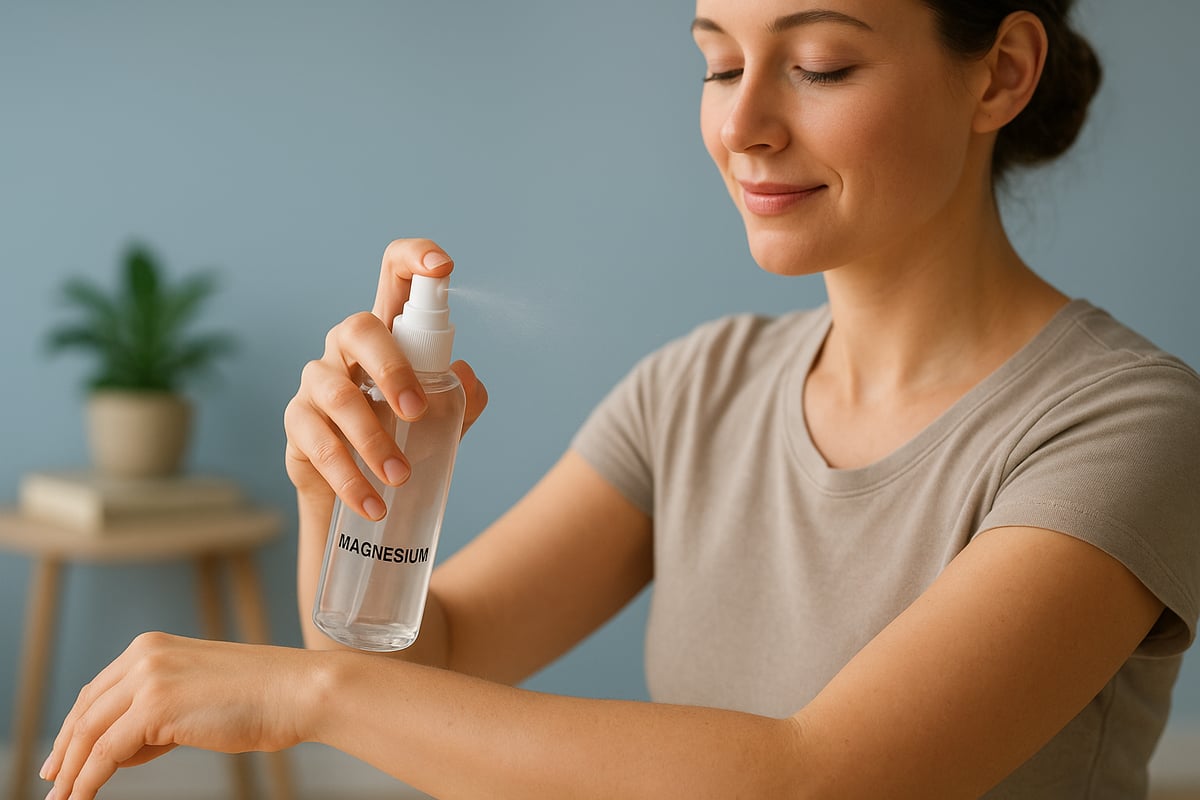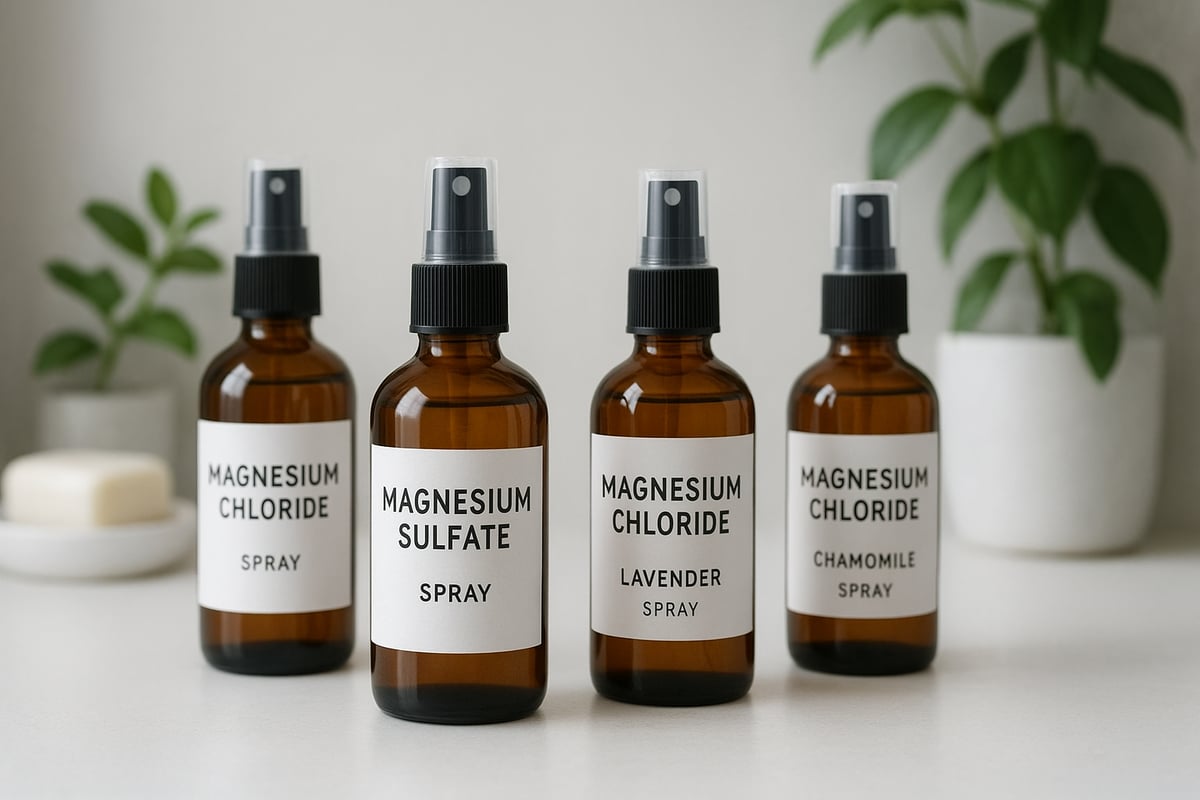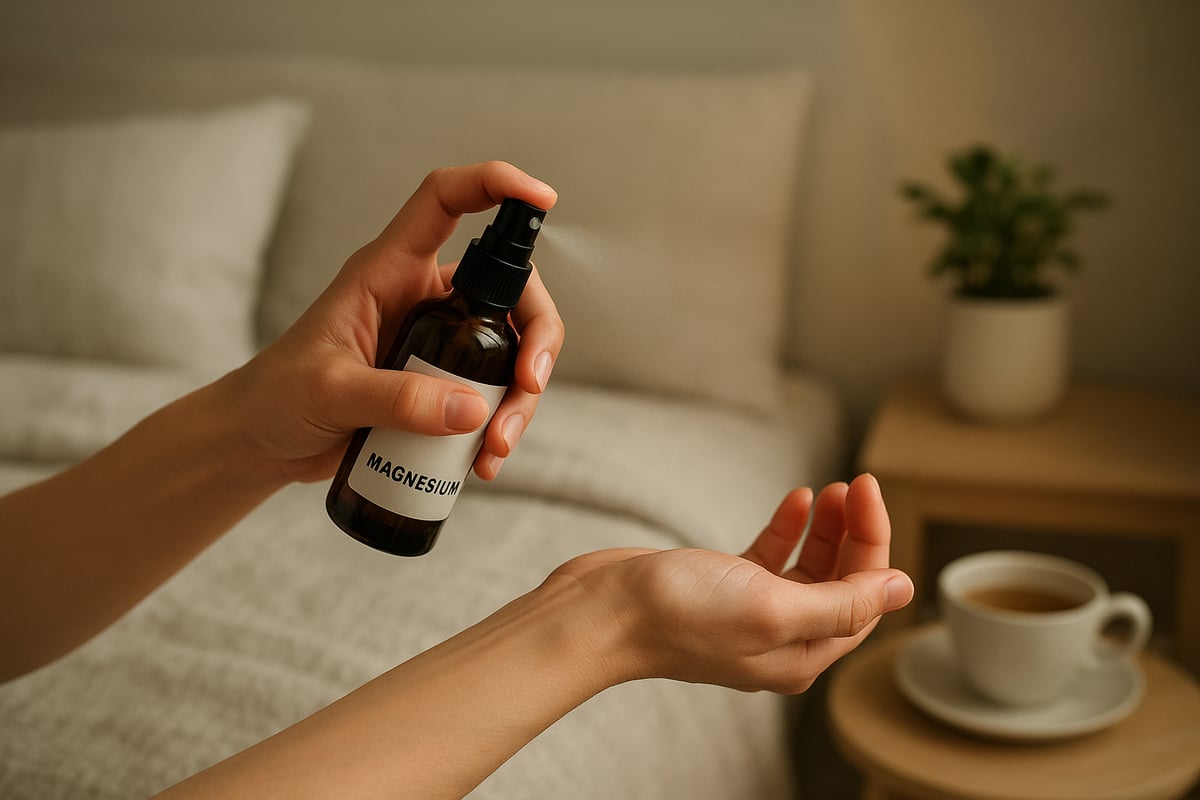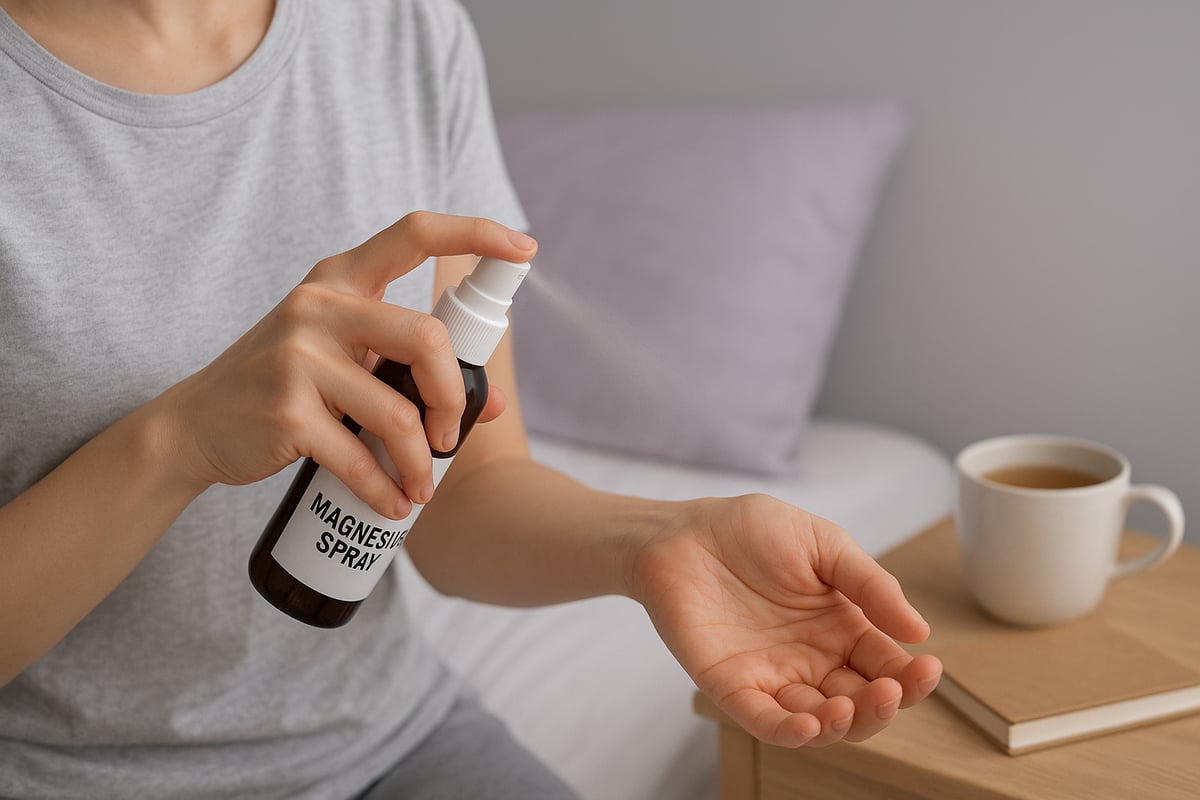Imagine a world in 2025 where you can manage anxiety with a simple spray, skipping pills and unwanted side effects. Millions struggle with anxiety every day, and more people are searching for holistic, effective solutions that actually fit into real life.
One standout option is magnesium spray for anxiety. Backed by scientific research and positive user stories, this natural remedy is quickly gaining popularity for those seeking calm and better sleep.
Are you ready to learn how magnesium spray for anxiety can boost your well-being? In this guide, you’ll discover seven expert-backed ways to use it for anxiety relief, restful nights, and a healthier mind.
Understanding Magnesium’s Role in Anxiety Relief
Anxiety can feel overwhelming, but understanding the science behind natural solutions offers hope. One increasingly popular option is magnesium spray for anxiety. Let's explore why magnesium is so important for mental well-being and how topical sprays may become your new go-to for relief.

What is Magnesium and Why Does It Matter?
Magnesium is an essential mineral your body needs for over 300 biochemical reactions. It plays a crucial part in nerve function, muscle relaxation, and especially in the regulation of neurotransmitters that affect mood and stress levels.
Shockingly, up to 50% of people may have suboptimal magnesium levels. Low magnesium has been linked to symptoms like anxiety, irritability, and trouble sleeping. If you often feel restless or tense, a deficiency could be contributing to your discomfort.
Scientific research supports the use of magnesium spray for anxiety. Studies reveal that supplementing magnesium can result in reduced anxiety symptoms, improved sleep, and better overall mood. For a deeper dive, you can read about Magnesium's role in stress and mental health, which explains how this mineral supports the nervous system and regulates stress responses.
There are two main ways to supplement magnesium: orally (through pills or powders) and topically (such as sprays). While pills are common, many people experience digestive side effects or poor absorption. Topical sprays deliver magnesium directly through the skin, bypassing the gut and supporting faster absorption.
Common signs of magnesium deficiency related to mental health include:
- Persistent nervousness or anxiety
- Difficulty falling or staying asleep
- Muscle cramps or twitching
- Fatigue or lack of focus
Understanding these basics lays the foundation for using magnesium spray for anxiety effectively.
Oral vs. Topical Magnesium: Quick Comparison
| Feature | Oral Magnesium | Magnesium Spray (Topical) |
|---|---|---|
| Absorption | Variable | Often higher |
| Digestive Impact | Possible upset | Rare |
| Onset of Effects | Slower | Quicker |
| Ease of Use | Needs swallowing | Simple spray |
How Magnesium Spray Works for Anxiety
Magnesium spray for anxiety works through a process called transdermal absorption. When you spray magnesium onto your skin, it passes through the outer layer and enters your bloodstream directly. This method offers several benefits for those seeking natural anxiety relief.
First, magnesium spray avoids common digestive issues that oral supplements can cause, such as stomach upset or diarrhea. This makes it an appealing choice for people with sensitive stomachs or those who want to avoid pills.
Users often report feeling calmer within 20 to 30 minutes of application. Clinical data and testimonials highlight reduced muscle tension, improved sleep quality, and a noticeable drop in anxious thoughts when using magnesium spray for anxiety regularly.
Safety is another advantage. Topical magnesium is generally well-tolerated, even for sensitive individuals. Most people can use it daily without side effects, though it's always wise to do a small patch test first.
If you’re looking for a gentle yet effective way to support your mental health, magnesium spray for anxiety could be the missing link in your wellness routine. By understanding how it works, you can make informed choices and experience greater calm each day.
Choosing the Right Magnesium Spray in 2025
Selecting the best magnesium spray for anxiety is crucial for effective and safe results. With so many options available in 2025, understanding what sets quality sprays apart will help you make an informed decision. The right choice can enhance your anxiety relief routine and maximize the benefits of magnesium spray for anxiety.

Key Ingredients and Formulations to Look For
When shopping for a magnesium spray for anxiety, the first thing to check is the type of magnesium used. Magnesium chloride and magnesium sulfate are the most common forms in sprays. Magnesium chloride is highly bioavailable and quickly absorbed through the skin, making it a popular choice. Magnesium sulfate, known as Epsom salt, is also effective but may be less potent than chloride.
Here’s a quick comparison:
| Magnesium Type | Absorption | Common Uses | Notes |
|---|---|---|---|
| Magnesium Chloride | High | Anxiety, muscle relief | Fast-acting, gentle |
| Magnesium Sulfate | Moderate | Muscle soaks, baths | May be less concentrated |
Purity is essential. Look for sprays that list magnesium as the main ingredient, with no artificial fragrances or preservatives. High concentration ensures you get enough magnesium per spray, while added ingredients like MSM, lavender, or chamomile can boost relaxation benefits.
Certifications matter, too. Choose sprays labeled as vegan, cruelty-free, non-GMO, or Canadian-made for added peace of mind. Packaging counts, especially if you plan to travel. A sturdy, leak-proof spray bottle makes it easy to apply magnesium spray for anxiety on the go. For a curated list of top-rated options, check out these best magnesium spray products for anxiety management.
Safety, Allergies, and Skin Sensitivity
Safety is a top priority when adding magnesium spray for anxiety to your routine. Start by doing a patch test on a small area of skin. Wait 24 hours to check for any irritation, especially if you have sensitive skin or allergies.
Avoid sprays with artificial fragrances or harsh preservatives. These can trigger skin reactions, particularly in those prone to allergies. Always read ingredient labels carefully before using a new magnesium spray for anxiety.
Age and health status matter, too. While most adults tolerate magnesium spray for anxiety well, children, pregnant women, and elderly individuals should consult a healthcare professional before starting. If you have a history of skin conditions or are on medication, medical advice is recommended.
By following these guidelines, you can confidently choose a magnesium spray for anxiety that fits your needs and supports your wellness journey.
7 Best Ways to Use Magnesium Spray for Anxiety in 2025
Struggling with stress or anxious thoughts? You are not alone. Many people are now turning to magnesium spray for anxiety, seeking a natural and science-backed solution that fits modern lifestyles. Here are the 7 best ways to make magnesium spray for anxiety part of your daily wellness routine in 2025.

1. Applying Magnesium Spray Before Bedtime
One of the most popular uses of magnesium spray for anxiety is as part of a nightly wind-down routine. Magnesium is known to support the nervous system and help regulate neurotransmitters involved in relaxation and sleep. When you apply magnesium spray for anxiety before bedtime, you may notice a calmer mind and an easier transition into restful sleep.
How to use it:
- Spray 5–10 pumps of magnesium spray for anxiety onto your feet, shoulders, neck, or wrists.
- Massage gently until absorbed.
- Do this 15–30 minutes before lying down.
Science suggests that magnesium can help reduce the time it takes to fall asleep and improve overall sleep quality. Many users report falling asleep faster and waking up less during the night after adding magnesium spray for anxiety to their routine.
Pair your bedtime application with other calming rituals:
- Meditation or breathing exercises
- A warm cup of herbal tea
- Soft music or gentle lighting
Tracking your results in a sleep journal can be helpful. Over a few weeks, you may see improvements in both sleep and anxiety levels. For more insights on how magnesium supports restful sleep and stress relief, see this Benefits of magnesium for anxiety guide.
2. Using Magnesium Spray During Anxiety Attacks
Magnesium spray for anxiety can provide fast, targeted relief during moments of acute stress. Its transdermal delivery allows magnesium to absorb quickly, potentially interrupting the body's stress response.
Quick steps for use during an anxiety attack:
- Apply magnesium spray for anxiety to pulse points like wrists, temples, or behind the knees.
- Take slow, deep breaths for one to two minutes.
- Focus on the cooling sensation and gentle aroma (if your spray includes calming botanicals like lavender).
Many individuals find that pairing magnesium spray for anxiety with controlled breathing helps ground them in the moment. This technique can be especially useful at work, in social settings, or whenever anxiety spikes unexpectedly.
Clinical data and user experiences suggest a noticeable reduction in symptoms like racing thoughts and muscle tension. However, if you find yourself using magnesium spray for anxiety multiple times daily, consider consulting a healthcare provider to ensure it fits your overall management plan.
3. Incorporating Magnesium Spray into Morning Routines
Starting your day with magnesium spray for anxiety can help set a calm, steady tone that carries through busy mornings. Applying magnesium spray for anxiety after your shower or before you get dressed lets your skin absorb it efficiently and prepares your mind for a positive, focused day.
Simple morning routine:
- After drying off, spritz magnesium spray for anxiety onto your shoulders, arms, or lower back.
- Rub in gently, letting it dry before putting on clothes.
- Combine with a few minutes of stretching or gratitude journaling.
This morning habit may help stabilize mood and support mental clarity, making it a favorite among professionals and students alike. Magnesium spray for anxiety works well with other wellness practices, such as mindful breathing or a nutritious breakfast, to reinforce emotional balance from the start.
Even a small dose in the morning can make a difference. Over time, this routine can help prevent baseline anxiety from building up, especially during high-stress periods.
4. Combining Magnesium Spray with Mindfulness Practices
Integrating magnesium spray for anxiety with mindfulness activities like meditation, yoga, or breathwork can amplify the calming effects of both. Magnesium is believed to influence brainwave patterns, supporting deeper relaxation and presence.
How to enhance your session:
- Apply magnesium spray for anxiety to your neck, chest, or wrists before starting.
- Use during gentle yoga or while seated for meditation.
- Notice the physical sensation as a cue to focus on your breath.
Many mindfulness practitioners report a heightened sense of ease and reduced muscle tension when using magnesium spray for anxiety alongside their regular practice. Try a simple 10-minute routine: spray, settle in, and follow a guided meditation or slow stretching sequence.
Testimonials often mention feeling more grounded and less distracted during sessions, making magnesium spray for anxiety a valuable tool for anyone looking to deepen their mindfulness journey.
5. Targeting Tension Points for Physical and Emotional Relief
Muscle tension and anxiety often go hand in hand. Magnesium spray for anxiety can help break this cycle by relaxing tight areas and soothing both body and mind.
Common tension points to target:
- Neck and shoulders (especially after screen time)
- Upper back and lower back
- Jawline and temples
Massage a few sprays of magnesium spray for anxiety into these areas, using circular motions for a minute or two. This can help release knots, ease “tech neck,” and melt away physical stress that fuels anxious feelings.
For best results, use magnesium spray for anxiety after a long day or intense workout. Many people find that regular application—two to three times per week—leads to less overall tension and a calmer, more resilient mood.
6. Integrating Magnesium Spray into Self-Care Rituals
Developing a consistent self-care routine is key for long-term anxiety management, and magnesium spray for anxiety fits perfectly into this approach. It pairs well with other holistic practices, creating a calming environment at home.
Ideas for a stress-busting self-care ritual:
- Start with a warm bath or shower
- Apply magnesium spray for anxiety, focusing on areas that feel tense
- Add aromatherapy (lavender, chamomile) and soft lighting
- Write in a journal or read a favorite book
Consistency is important. Set aside dedicated time each week for your self-care ritual, making magnesium spray for anxiety a non-negotiable part of your plan. Many users find that these routines not only lower anxiety but also improve overall well-being and resilience to daily stressors.
7. Using Magnesium Spray for Travel and On-the-Go Anxiety
Travel can be a major trigger for anxiety, but magnesium spray for anxiety offers a portable, discreet solution. Travel-sized bottles are easy to carry in your bag or pocket, making relief accessible wherever you are.
Tips for using magnesium spray for anxiety while traveling:
- Choose TSA-approved mini sprays for flights
- Apply to wrists or neck before boarding or in stressful environments
- Use in hotel rooms, busy airports, or unfamiliar places
Combine magnesium spray for anxiety with other travel-friendly techniques like acupressure, calming apps, or guided breathing. Many travelers report feeling more relaxed and in control, whether on a business trip or vacation.
Having magnesium spray for anxiety at hand can make all the difference when routines are disrupted and new environments feel overwhelming.
Maximizing Results: Dosage, Frequency, and Best Practices
Getting the most out of magnesium spray for anxiety starts with using the right amount at the right times. Applying too little may not offer relief, while overuse could cause irritation or other issues. Let’s break down how to maximize benefits safely and effectively.

Finding Your Ideal Dosage
For most adults, 5-10 sprays of magnesium spray for anxiety per application is a common starting point. This usually equals about 50-100 mg of elemental magnesium. Always check your spray’s concentration, as products can vary.
A helpful dosage guide:
| Application Area | Number of Sprays | Approx. Magnesium (mg) |
|---|---|---|
| Feet | 4-5 | 40-60 |
| Shoulders/Neck | 2-3 | 20-40 |
| Wrists | 1-2 | 10-20 |
| Total (per use) | 5-10 | 50-100 |
Apply magnesium spray for anxiety up to twice daily, adjusting based on your needs. If you experience intense anxiety, a second application in the afternoon or evening can help. Children, pregnant women, or those with sensitive skin should start with fewer sprays and consult a healthcare professional.
Adjusting Frequency and Tracking Progress
Consistency is key for results. Use magnesium spray for anxiety daily for best outcomes. If you are just starting, try a single daily application for a week, then assess your response.
To track benefits, keep a symptom journal. Note when you use magnesium spray for anxiety, how you feel before and after, and any skin reactions. This helps you identify what works and avoid overuse.
Watch for signs of too much magnesium, such as mild skin tingling or redness. If you notice these, reduce the number of sprays or frequency. Rarely, excessive use may cause loose stools or low blood pressure, especially in sensitive individuals.
Integrating with Other Anxiety Management Tools
Magnesium spray for anxiety works best as part of a broader self-care plan. Pair it with calming routines like meditation, balanced nutrition, and regular exercise. Therapy or counseling can further support anxiety management.
Scientific research, such as this systematic review on magnesium supplementation and anxiety, shows promising effects for those with mild to moderate symptoms. Remember, results can vary. Some people notice relief within days, while others may need several weeks of regular use.
Avoid common mistakes like inconsistent application or using spray on broken skin. For long-term benefits, stick to your routine and adjust as needed.
By following these best practices, you can safely harness the calming power of magnesium spray for anxiety and support your journey toward greater wellness.
Frequently Asked Questions About Magnesium Spray for Anxiety
Curious about magnesium spray for anxiety? Here are answers to the most common questions, so you can make informed choices for your wellness routine.
Can magnesium spray for anxiety replace prescription anxiety medications?
Magnesium spray for anxiety may help support relaxation and stress management, but it should not be considered a substitute for prescription medications. Always consult your healthcare provider before making changes to your treatment plan. Research shows magnesium can complement other approaches, but it is not a cure-all.
Is magnesium spray safe for children and pregnant women?
Generally, magnesium spray for anxiety is safe for most adults. For children or pregnant women, consult a healthcare professional before starting any topical magnesium product. Sensitive skin or specific health conditions may require extra caution.
How does magnesium spray compare to oral supplements?
Topical magnesium spray for anxiety is absorbed through the skin, bypassing the digestive system. This can be helpful for people with sensitive stomachs or who want faster results. For more details, see this magnesium and mental health overview.
Are there any side effects or contraindications?
Most people tolerate magnesium spray for anxiety well. Mild side effects can include tingling, itching, or irritation at the application site. Rarely, excessive use may cause more pronounced discomfort. Always do a patch test before regular use.
What should I do if I experience skin irritation?
If you notice redness or irritation after applying magnesium spray for anxiety, wash the area with water and discontinue use. Try applying to less sensitive areas, or look for sprays with fewer additives. Persistent issues should be discussed with a healthcare provider.
How long does a typical bottle last with daily use?
A standard bottle of magnesium spray for anxiety usually lasts about one to two months with daily application, depending on the size and frequency of use. For a variety of options and bottle sizes, explore this magnesium collection for wellness.
Can I use magnesium spray with other topical products or medications?
Yes, magnesium spray for anxiety can often be used alongside other skincare products. Apply magnesium spray first and allow it to absorb before layering other products. If you are using prescription creams or have sensitive skin, check with your doctor first.
Now that we’ve explored the science behind magnesium spray and the practical ways to use it for anxiety relief in 2025, you might be wondering how to get started with a solution that’s natural, pure, and effective. Nuvo Wellness crafts their magnesium sprays right here in Canada, free of artificial fragrances and harsh chemicals, so you can feel confident about what you’re putting on your skin. If you’re ready to experience a calmer mind and better sleep with a product trusted by wellness enthusiasts, Try it Now and take the next step toward a more relaxed, balanced you.

